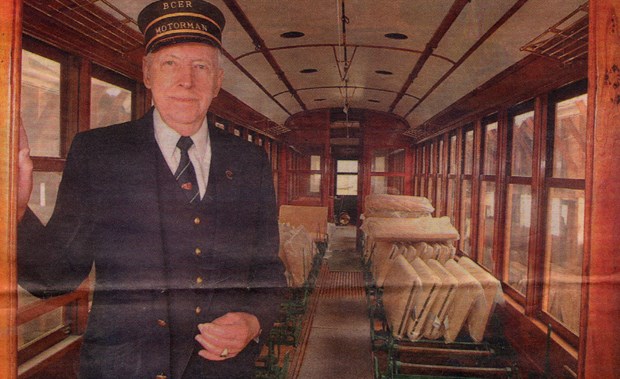With his flat-topped cap, smart navy uniform and cheery smile, Vic Sharman was always ready to take anyone he chatted with on a ride back in time.
It was a familiar route — from Steveston to Marpole and back again — aboard the B.C. Electric Railway’s tram 1220. In recent years, he did it with stories drawn from his experience in the 1940s as a motorman (driver) along the route that not only provided an important transportation link, but instilled a sense of community for those who climbed aboard.
Sharman passed away on Dec. 15, a couple of months shy of his 92nd birthday.
He retired in 1987 from B.C. Transit, where he was a senior vice president. But his love and dedication to the tram is destined to live on in the memories of those who encountered him.
One was Ron Hyde, who interviewed Sharman for his book The Sockeye Special: The story of the Steveston tram and early Lulu Island.
Hyde said Sharman always spoke glowingly of his job guiding the tram along the Interurban Line that was built in 1902 and owned by the Canadian Pacific Railway.
In 1905, the CPR leased the line to the BC Electric Railway Company which electrified the line and ran the tram service until 1958.
Hyde said Sharman made up one half of the two-person crew aboard Tram 1220 which now sits inside safely inside the Steveston Interurban Tram Building near the corner of No. 1 Road and Moncton Street.
While Sharman drove the tram, a conductor collected fares from passengers, many of whom became like family as they made frequent trips on the handy service that, before the influx of cars in the post Second World War boom, made it a prime transportation route.
The initial cost of a return trip to Steveston was 85 cents, with trains running every half hour in rush hour and hourly at other times.
Hyde said Sharman knew most passengers by name.
In the mornings there was often a double car service that would ferry children back and forth to Richmond High School.
One of those regular riders was Coun. Harold Steves who said he remembers riding up front with the driver to get a first-hand look at what it took to guide the tram.
“That was the place to be, all the kids wanted to be up there and chat with the drivers who were like family to us,” he said. “They got to know pretty much everyone who was on their tram.”
There was even a regular enquiry if they youngsters had managed to finish all of their homework.
Steves said the tram link also made it possible for young local hockey players to make the trip into Vancouver to practise and play games, since Richmond at the time had no rink.
“We’d be up early to catch the 5 a.m. tram that would get us to Kerrisdale Arena and then take one back in time for school at 9 a.m.,” he said.
But it wasn’t just people the tram carried. Hyde said the route was an important link for local dairy farmers who wanted to get their milk to dairies in Marpole.
“So, the milk cans were loaded onto the tram and sent to Vancouver, and they’d come back full of spring water,” Hyde said. “They did that because you couldn’t dig water wells in Richmond, and the famers needed the water for their livestock.”
In his book, Hyde wrote that the Lulu Branch of the tram line began at Eburne Junction at the north end of Lulu Island and eventually had 18 stations built along the 13-kilometre route. Stations were named after landowners who donated land in order to have the BCER install a stop nearby.
Mayor Malcolm Brodie said he met Sharman at numerous tram-related events over the years and marveled at his continued interest in having it preserved.
“He followed the history of that tram. It was a very special item for him, and he always had time to tell people what it was like to be aboard way back in the day, and provide some guidance in getting it restored.”
In mid-December city council voted to spend around $400,000 to continue restoration efforts on the tram, including a new roof, leather seating and brass finishing.
Brodie said that for most people today in Richmond the old tram service is only seen in mere glimpses.
“And the reason we are finishing off the restoration this year is that it’s such an important artifact in our history,” Brodie said, adding while he favoured having it become a running tram once more it would have been expensive proposition.
“It’s destined to be a static display. But there’s something special about the tram. It just takes runs away with your imagination,” Brodie said.
Steves said he also would have liked to see the tram run again and believes there still is a possibility that in the future it could roll along a short line from Bayview Street to the Gulf of Georgia Cannery.
If that time does come, it would likely bring an even broader smile to Vic Sharman’s face.
A memorial service for Sharman is being held at 1 p.m. on Saturday (Jan. 9) at Trinity Baptist Church in Vancouver (1460 West 49th Ave.).



